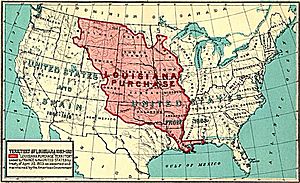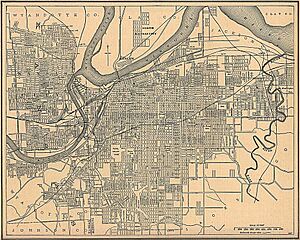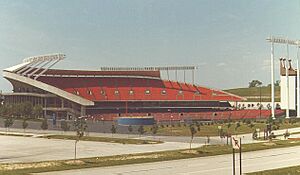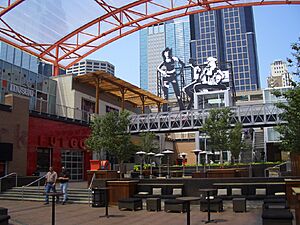History of the Kansas City metropolitan area facts for kids
The history of the Kansas City area began in the 1800s when French fur traders from St. Louis, Missouri traveled up the Missouri River. They came to trade furs with Native American tribes. This spot, where the Kansas and Missouri Rivers meet, became a key place for trade and safety. It's now known as the Kansas City metropolitan area, stretching across the border of Missouri and Kansas. Kansas City, Missouri was founded in 1838. It quickly grew bigger than nearby Westport and became the most important city west of St. Louis. The area played a huge part in the United States' move westward, as famous routes like the Santa Fe and Oregon trails passed through it. In 1854, when Kansas was opened for settlement, the Missouri-Kansas border became an early battleground in the American Civil War.
Contents
Exploring the Area
Early French Explorers
The first European to visit the Kansas City area was a Frenchman named Étienne de Veniard, Sieur de Bourgmont. He was also the first to explore the lower Missouri River. Bourgmont had left his post at Fort Detroit and lived with a Native American wife near Brunswick, Missouri.
To clear his name, Bourgmont wrote detailed descriptions of the land and rivers in 1713 and 1714. He was the first to call the rivers by their current names: the Kansas and Missouri. A French mapmaker used his notes to create the first accurate map of the area.
Bourgmont was later honored by the French. In 1724, he led a group of Native Americans to the southwest to make friends with the Comanche tribe. This was part of a plan to expand French influence from Montreal all the way to New Mexico, passing through Kansas City. After this success, he took Native American chiefs to Paris to meet Louis XV and see famous places like Versailles.
Bourgmont stayed in France, and the Spanish later took control of the region in 1763. However, French traders continued their fur business under Spanish permission.
Lewis and Clark's Visit
After the Louisiana Purchase in 1803, the Lewis and Clark Expedition set out to explore the new lands. In 1804, Lewis and Clark camped for three days where the Kansas and Missouri rivers meet. They met French fur traders and mapped the area, noting it would be "a fine place for a fort." This spot is now Kaw Point Park in Kansas City, Kansas.
Because trade was growing along the Missouri River, the United States government wanted to set up posts in the area. In 1808, Fort Osage was built about 20 miles (32 km) from the river junction.
The Kaw's Mouth Area
In 1812, the northern part of the Louisiana Territory was renamed the Missouri Territory. When Missouri became a state in 1821, its western border was set along the Missouri River to where it meets the Kansas River (also called the Kaw). This area, known by many names over time like "Chouteau's" and "Town of Kansas," has seen several floods and river changes. Since 1800, the river junction has moved about a quarter mile (0.4 km) up the Missouri River.
Early to Mid-1800s: A Growing Frontier
Native American Presence
After Missouri joined the United States in 1821, many Shawnee people were moved from southeastern Missouri to southeastern Kansas. In 1826, a Shawnee leader named Prophet Tenskwatawa started a village in Argentine, Kansas. By 1833, only a group called Black Bob's band of Shawnee resisted moving. They settled near Olathe and along the Kansas River. Tenskwatawa passed away in 1836 in his village in Kansas City, Kansas.
First European Settlers
The first European settlers in Kansas City spoke French. In 1821, François Gesseau Chouteau set up a permanent trading post in a bend of the Missouri River. He called it "the village of the Kansa." After a flood in 1826, Chouteau moved his trading post to higher ground. He also helped build the first Catholic church in the area.
The area soon attracted trappers, scouts, traders, and farmers. This led to the creation of Jackson County, Missouri, in 1827 and the founding of Independence as its county seat. As more farmers arrived, fur traders moved further north. In 1831, Moses Grinter started a ferry service on the Kansas River, becoming one of the first permanent white settlers in the Kansas City, Kansas, area.
Latter Day Saints in Jackson County
In 1831, members of the Latter Day Saint church, founded by Joseph Smith, arrived from Ohio and New York. They bought about 2,000 acres (8.1 km²) of land in the area. However, disagreements between the Saints and other Missouri residents led to the Saints being asked to leave Jackson County in 1833.
Later, different groups of Latter Day Saints returned to Jackson County. The largest group, The Church of Jesus Christ of Latter-day Saints (LDS Church), opened the Kansas City Missouri Temple on May 6, 2012.
Westport and Westport Landing
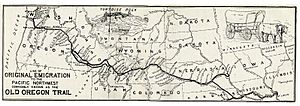
The character of Kansas City was shaped by those who lived near the river and those who lived in the hills. John Calvin McCoy, often called the "father of Kansas City," helped establish settlements in both areas. In 1833, he opened a trading post in the hills, three miles (4.8 km) south of the river. McCoy named it "West Port" because it was the last place for travelers to get supplies before heading into Kansas Territory on trails like the California Trail, Santa Fe Trail, and Oregon Trail. McCoy received supplies from boats that docked at a rocky spot on the river, which was called "Westport Landing." In 1834, the steamboat John Hancock was the first to dock at Westport Landing, opening a new era of travel and trade for the area.
The Town of Kansas
Expansion around the landing was difficult because most of the land was a farm owned by Gabriel Prudhomme. In 1838, McCoy, Chouteau, and other business owners formed the Town of Kansas Company. They bought Prudhomme's 271-acre (1.1 km²) farm for about $4,220. The investors considered other names like Port Fonda and Rabbitville, but chose Kansas. In 1839, Chouteau passed away, and the town outside Westport Landing was officially named Kansas.
Throughout the 1840s, Kansas grew in population and importance. It, along with nearby Independence and Westport, became key starting points for settlers heading west on the Oregon, Santa Fe, and California trails. By 1847, the first railroad reached Kansas.
Jackson County formally recognized Kansas, Missouri, on June 3, 1850. This date is often seen as Kansas City's founding. Its population was about 1,500 people. The first newspaper and telegraph service were established in Kansas in 1851.
The City of Kansas
On March 28, 1853, Missouri officially incorporated the town, renaming it the City of Kansas. In the first election in 1853, there were 67 voters from an estimated population of 2,500. The initial city area was about 10 blocks wide and five blocks long. William S. Gregory was elected the first mayor but had to resign because he didn't live within the city limits. Johnston Lykins then became the first legal mayor.
Border Conflicts
At the time the City of Kansas was formed, Missouri was a slave state. However, people in the area had strong disagreements about slavery. In 1854, the United States Congress passed the Kansas–Nebraska Act. This law changed the 1820 Missouri Compromise, which had forbidden slavery in new states north of a certain line. Now, new territories like Kansas could choose whether to allow slavery.
As a result, groups who supported slavery came into Kansas Territory from Missouri. Those who wanted Kansas to be a free state called them "Border Ruffians." Pro-slavery Missourians helped elect a pro-slavery Kansas Territorial Legislature. In response, people who opposed slavery arrived and formed their own government in Lawrence, Kansas. The new City of Kansas found itself in the middle of this conflict, known as Bleeding Kansas.
Despite the fighting, the City of Kansas continued to grow. It gained a courthouse, city market, and chamber of commerce by 1857. By 1858, the violence was so bad that the Kansas Territorial Governor and the State of Missouri asked President James Buchanan to send in federal troops, which helped calm things down.
Civil War Era
Missouri remained part of the Union during the Civil War. However, there was much tension in Kansas City between those who supported the Union and those who supported the Confederacy. Confederate General Sterling Price fought battles in the area, hoping to encourage residents to join the Southern cause. The City of Kansas became a center of military activity. The First Battle of Independence was a Confederate victory, but they couldn't take the City of Kansas because it was too well-defended by Union troops.
In 1863, William Quantrill and his raiders attacked and burned Lawrence, killing many people. This event was partly motivated by the collapse of a makeshift prison in Kansas City that held women connected to the raiders. Union General Thomas Ewing, Jr. believed the raid started in four Missouri counties near the Kansas border. He issued General Order No. 11, which ordered everyone living in rural areas outside of towns to leave, regardless of their loyalty. This caused lasting anger among residents.
In 1864, General Price invaded Missouri again. He pushed Union troops out of Independence and into the City of Kansas, leading to the important Battle of Westport in October. Price was defeated and forced out of the state, ending major Confederate military actions in the area.
After the war, Kansas City remained a place where many former Southern supporters lived. John Newman Edwards started the Kansas City Times newspaper to oppose Republican rule. He also helped create the image of Jesse James as a hero fighting against an unfair government. Jesse James later robbed the Kansas City fairgrounds.
Mid to Late 1800s: A Crossroads of the Country
Railroad Hub
In 1865, the Missouri Pacific railroad reached Kansas City. At that time, Kansas City was similar in size to Independence and Leavenworth, Kansas. This changed in 1867 when Kansas City was chosen over Leavenworth for the Hannibal & St. Joseph Railroad bridge across the Missouri River. The Hannibal Bridge, designed by Octave Chanute, opened in 1869. After this, the city's population grew four times larger in 50 years.
In 1889, with about 130,000 people, the city adopted a new plan and officially changed its name to Kansas City. In 1897, Kansas City took over Westport. The main railroad tracks met in the West Bottoms, an area previously used to equip travelers on the Oregon and Santa Fe trails. This area became the Kansas City Stockyards. Kansas City soon became the second busiest train center in the country, after Chicago. In 1914, the old Union Station in the West Bottoms became too small, and a new, larger Union Station was built.
"Cow Town" Identity
In 1871, the Kansas City Stockyards in the West Bottoms became very successful because of their central location and access to trains. They grew to be the second largest in the country, only behind Chicago's. The city became known for its famous Kansas City steak. In 1899, the American Hereford Association held a cattle judging contest in the stockyards. This event soon became the annual American Royal, a two-month-long livestock festival. The Kansas City Stockyards were badly damaged in the Great Flood of 1951 and never fully recovered.
Strawberry Hill
In 1887, a beautiful Victorian home was built for John and Margaret Scroggs in the Strawberry Hill area of Kansas City, Kansas. It's a great example of the Queen Anne Style of architecture.
1890s to 1940: The Pendergast Era and Growth
The Pendergast era, led by political bosses James and Tom Pendergast from 1890 to 1940, was a very colorful and important time for Kansas City. During this period, the Pendergasts made sure that national prohibition (the ban on alcohol) was not strictly enforced in Kansas City. Many important things happened:
- The Kansas City boulevard and park system was developed.
- The Country Club Plaza, Country Club District, and Ward Parkway were created.
- TWA (Transcontinental & Western Airline) made Kansas City a major hub for national aviation.
- Most of the downtown Kansas City buildings were constructed.
- The city's culture thrived with contributions to Negro league baseball, Kansas City jazz music, and Kansas City-style barbecue cuisine.
- The stockyards and train station were second only to Chicago.
- Harry S Truman, from nearby Independence, became President.
Much of the construction during these "wide open days" used Pendergast's concrete company. The era was also known for some violence and corruption. Tom Pendergast was eventually charged with income tax evasion in 1939.
World War I Memorial
The Liberty Memorial, which houses The National World War I Museum, was dedicated on November 11, 1926, by U.S. President Calvin Coolidge. Important leaders from Belgium, Great Britain, Italy, France, and the United States attended the groundbreaking ceremony in 1921.
Important People of the Era
Walt Disney
Walt Disney moved to Kansas City with his family in the early 1900s. He took classes at the Kansas City Art Institute. It's said he was inspired to create his famous mouse character after seeing a mouse in his Kansas City office. After World War I, Disney ran his first animation studio, Laugh-O-Gram Studio, in Kansas City from 1921 to 1923.
Joyce Clyde Hall
J.C. Hall founded the greeting card company Hallmark Cards with his brother Rollie in the early 1900s. He started by selling Valentine's Day cards. He later expanded the company's headquarters into Crown Center.
TWA Airline
Charles Lindbergh helped convince the new Transcontinental & Western Airline (TWA) to put its main office in Kansas City because of the city's central location. During the 1930s and 1940s, TWA was known as "The Airline Run by Flyers." Before World War II, the airline had about 300 employees, but it eventually employed over 20,000 people from the Kansas City area.
William T. Kemper
William T. Kemper became the head of a powerful financial family. They controlled two of the city's biggest banks. The Kemper family has influenced many financial projects in Missouri and Kansas, including Kemper Arena and the Kemper Museum of Contemporary Art.
William Rockhill Nelson
William Rockhill Nelson founded the Kansas City Star newspaper in 1880. He later took over its main competitor, the Kansas City Times. Nelson was a strong supporter of the Democratic Party and a promoter of the city. His newspaper encouraged the city to build Memorial Hall in 1899 to attract a national political convention. Nelson also arranged for his house to be torn down after his death to create the Nelson-Atkins Gallery of Art.
J. C. Nichols
Starting in 1906, developer J. C. Nichols created a planned upscale community called the Country Club District. It's known for Ward Parkway, a wide, tree-lined boulevard with large homes. In the 1920s, Nichols created the Country Club Plaza, a shopping area and neighborhood inspired by the city of Seville, Spain. "The Plaza" was the world's first shopping center designed for shoppers arriving by car. It's still a very popular place for shopping and dining. Every Thanksgiving evening, many Kansas Citians gather there to watch the traditional Lighting of the Plaza, which starts the Christmas shopping season.
Nichols also used practices like "redlining" and residential agreements that prevented Black people, Jewish people, and other minority groups from buying homes in more desirable areas, like the neighborhoods he developed around the Plaza. This division continued in parts of the city, especially east of Troost Avenue. Because of this, J.C. Nichols' name was removed from a fountain and street on The Plaza.
Harry S Truman
Harry S Truman was born in Lamar, Missouri but grew up in Jackson County. After World War I, he started a clothing store in downtown Kansas City. When his business failed, he got a job through Tom Pendergast and became an Eastern Jackson County judge (which was like a county commissioner). Truman was later elected as a Senator. He was one of the few politicians who attended Tom Pendergast's funeral in 1945, just days after he became Vice President. He then became President of the United States when Franklin Roosevelt passed away on April 12, 1945. Truman went on to win the next presidential election in 1948 and served another term.
R. A. Long's Impact
In 1873, Robert A. Long started a hay business in Kansas. When that wasn't successful, he and his partners started a lumber company, R. A. Long & Company. In 1887, they formed the Long-Bell Lumber Company and moved its headquarters to Kansas City. This became a very successful business, making Long a millionaire. Long was also a developer, investor, and supporter of good causes. He built towns like Longville, Louisiana, and Longview, Washington. In 1907, he built the R.A. Long Building, the first steel-framed skyscraper in Kansas City. Long was also a founding member and president of the Liberty Memorial Association, which raised money for the memorial. In 1911, Long built Corinthian Hall, a large mansion, and in 1914, he built the Longview Farm.
18th Street & Vine: A Cultural Hub
One of the most exciting developments of this era was the growth of the inner-city neighborhood of 18th Street and Vine.
Kansas City Monarchs
The Kansas City Monarchs played at Municipal Stadium and were one of the best baseball teams in the Negro leagues. They had championship teams and famous players like Satchel Paige, Jackie Robinson, and John Jordan "Buck" O'Neil.
Kansas City Jazz
Because Kansas City didn't strictly enforce liquor laws and clubs could stay open all night, musicians started all-night jam sessions after their regular performances. The Kansas City sound was energetic, based on riffs, and influenced by the blues. This was the environment where Charlie Parker developed his skills before moving to New York City and helping create bebop music.
Kansas City-style Barbecue
Henry Perry first brought a Memphis-style barbecue to Kansas City from his restaurant in the 18th Street and Vine area in the early 1900s. Arthur Bryant later added more molasses to the recipe when he took over Perry's restaurant. Gates Bar-B-Q, opened in 1946 by George W. Gates, is the only remaining family-owned barbecue restaurant in the area. It's also the only sauce and product maker based in Kansas City.
Mid-20th Century: A Global Crossroads?
The period between the 1940s and 1970s was a hopeful time when Kansas City was sometimes seen as a major global center. This was boosted by hometown native Harry Truman being President from 1945 to 1953, followed by Kansan Dwight D. Eisenhower from 1953 to 1961. TWA, headquartered in Kansas City, also played a big role. The city hoped to become a gateway to the world. However, these big dreams faded as TWA's presence in the city lessened.
The 1940s
After the Pendergast political machine lost power, John B. Gage was elected mayor in 1940, and L. P. Cookingham became city manager. Their government aimed to "clean up" Kansas City from its corrupt past and bring in fair government practices.
World War II brought defense jobs to Kansas City, which was still recovering from the Great Depression. Factories like the Pratt & Whitney engine plant and other arms plants provided many jobs. This was a time of good fortune for the city. In 1945, Harry Truman, a resident of Jackson County, became President of the United States.
City Expansion
In the mid-1940s, the city government began to add more land to Kansas City, expanding its size five times over by the 1970s. After World War II, like many other cities, Kansas City saw people moving from the city center to the suburbs. While other cities shrank, Kansas City's new land helped it keep its population. However, growth has been limited since 1970. It's still common to see farms and corn fields on the far edges of Kansas City.
The 1950s
Since the 1950s, Kansas City has tried to change its "Cow Town" image. This began when Kansas City was in the national spotlight with Presidents Harry Truman and Dwight D. Eisenhower.
Changes started in the early 1950s as railroads declined due to cars and airplanes. Union Station, once a very busy train hub, began to decline. The Great Flood of 1951 severely damaged the Kansas City Stockyards. The stockyards never fully recovered as livestock businesses moved away from city centers. In 1955, Kansas City officially entered major league sports when the Philadelphia Athletics baseball team moved to the city, becoming the Kansas City Athletics.
The 1960s
The 1960s saw many new projects but also a rapid decline in many inner-city neighborhoods. Many historic buildings were torn down to make way for parking lots and office buildings. The area became more focused on business than on daily city life.
During this inner-city decline, Kansas City continued to expand its area. It eventually became one of the largest cities in the United States by land size, covering 318 square miles (820 km²). However, its population decreased by 15,000 between 1950 and 2000.
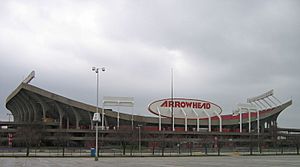
In 1967, the Kansas City Chiefs played in the first Super Bowl, losing to the Green Bay Packers. That year, the Kansas City Athletics baseball team moved away. In response, Kansas City approved a plan to build the Truman Sports Complex on the eastern edge of the city. This complex was so successful that many major league stadiums have since been designed based on its plan.
Also in 1967, work began on the Crown Center complex, located around the Hallmark Cards headquarters. Another development in the 1960s was the approval to move the city's main airport from downtown to the TWA Kansas City Overhaul Base, which became Kansas City International Airport (MCI). While Kansas City expanded outwards, the inner city faced challenges, including fires and a riot in 1968 after the assassination of Martin Luther King Jr. Many white residents moved out, which ironically led to more segregation in the city.
The 1970s
The early 1970s were dominated by Kansas City's big urban renewal projects, which were highlighted when the city hosted the 1976 Republican National Convention. These projects removed many historic buildings for more parking, offices, and public housing, but they didn't do much to bring people back to the city center.
New Sports Teams and Arenas
After the Kansas City Athletics left, Major League Baseball gave Kansas City a new expansion team, the Kansas City Royals, which started playing in 1969. The Royals had winning seasons by 1971 and moved into their new home at Royals Stadium (now Kauffman Stadium) in the Truman Sports Complex in 1973. They went on to appear in the World Series twice (winning once) and won six division titles. In 1972, the Kansas City Chiefs played their first game at the new Arrowhead Stadium.
In 1972, Kansas City also got a National Basketball Association team, the Cincinnati Royals, with promises of a new indoor arena. Kemper Arena, designed by architect Helmut Jahn, was built in 18 months from 1973 to 1974 at the former site of the Kansas City Stockyards. Its construction was funded by bonds and donations. The arena was considered an architectural marvel because it was built quickly and had no blocked views. Its construction helped Kansas City host the 1976 Republican Convention. The arena also led to Kansas City getting a National Hockey League expansion team, the Kansas City Scouts, which began playing in 1974.
KCI Airport
The Kansas City Downtown Airport was convenient but didn't have room to expand, and jets had to avoid tall bluffs nearby. TWA, which had its overhaul base 15 miles (24 km) north of downtown, had a landing strip surrounded by open land. This was called Mid-Continent International Airport.
In 1966, voters approved a $150 million plan to move the city's main airport to an expanded Mid-Continent. After some legal battles, Kansas City took over the airport, and it was renamed Kansas City International Airport (MCI) in 1972. The "MCI" abbreviation stuck because it was already on navigation charts.
On November 7, 2017, Kansas City voters overwhelmingly approved a new, privately funded single terminal at KCI. This new terminal is expected to open in late 2021.
Major Storms
Kansas City is in Tornado Alley and often experiences tornadoes. However, two major non-tornado storms had a big impact on the city. On September 12, 1977, after a very wet summer, 16 inches (410 mm) of rain fell on Kansas City, causing severe flooding. The worst flooding was in the Country Club Plaza neighborhood along Brush Creek. The storm killed 25 people and caused nearly $100 million in property damage. On June 4, 1979, a severe thunderstorm caused the roof of Kemper Arena to collapse. Luckily, no one was injured as there was no event that night. Investigations showed that heavy rain collected on the roof, and strong winds caused the collapse. The arena was repaired and reopened in early 1980.
Late 20th Century: A Smaller Major League City
Kansas City's big dreams began to shrink in the 1980s as TWA and its major league hockey and basketball teams left. The NCAA also stopped holding its men's basketball championship "Final Four" games in the city. The Kansas City Scouts hockey team moved to Denver in 1976, and the Kansas City Kings basketball team moved to Sacramento, California, in 1986. Kansas City began to accept that it was one of the smallest cities with major league sports teams. Since 1980, the city has approved large bond issues to protect historic buildings like Union Station and Liberty Memorial, and to make major improvements to Kansas City International Airport and the Truman Sports Complex. Downtown Kansas City then saw its biggest building boom since the Pendergast era.
The 1980s
School Desegregation Case
One of the most debated issues in Kansas City in the 1980s and 1990s was a school desegregation case. It lasted for three decades, cost millions of dollars, and even went to the U.S. Supreme Court. By 1970, the Kansas City school district had lost many white and middle-class Black students, leading to less tax money and a severe shortage of funds. The district relied more on federal money, which often required it to integrate schools faster.
The legal case began in 1977 when the Kansas City, Missouri School District sued neighboring districts for money to help desegregate its schools. A federal court judge took control of Kansas City's school system. The judge ordered tax increases to improve the schools as the system built special "magnet schools" with unique programs. The case involved the entire state of Missouri, as schools outside the city argued they shouldn't have to pay for Kansas City schools. Kansas City residents were also upset about plans to bus students for an hour or more each day across the city's large area.
At the peak of the debate, the Kansas City, Missouri district spent over $11,700 per student, which was the most of any large public school district in the country. Teacher salaries increased, and some schools were equipped with Olympic-size swimming pools and wildlife sanctuaries. The district hoped to stop white students from leaving and achieve 35% white enrollment in nearly every school. Instead, over the course of the case, minority enrollment grew from 67% to 84%. In 1995, the U.S. Supreme Court ruled that the courts had gone too far in the case. The case continued in lower courts, and in 2003, a federal court judge finally ended the judicial oversight of Kansas City's schools.
Hyatt Regency Walkway Collapse
One of the biggest symbols of Kansas City's rebirth in this era was Crown Center, built by Hallmark Cards. The newest part of the complex was the Hyatt Regency Hotel. On July 17, 1981, during a "tea dance" event, a walkway inside the building collapsed. This tragic event killed 114 people, making it the deadliest structural collapse in U.S. history at the time, and injured over 200 others. The Kansas City Star newspaper, which had been caught off guard after the Kemper Arena collapse, hired a structural engineer after the Hyatt disaster and won a Pulitzer Prize for its reporting on the story.
Royals Win World Series
The Kansas City Royals helped boost the city's spirits in 1980 when they played in their first World Series (losing to the Philadelphia Phillies). Then, in 1985, they played in the "I-70 Series" against their state rivals, the St. Louis Cardinals. The 1985 Royals won their division for the second year in a row and the sixth time in ten years. Their pitching was strong, led by Bret Saberhagen, who won the Cy Young Award. In the playoffs, the Royals won the American League Championship Series for only the second time, both times winning in seven games after being down three games to one.
The championship series against the Cardinals, where the Royals were the underdog, is remembered for some controversial umpire calls. However, the Royals won their first world championship over the Cardinals in Game 7, 11–0, winning the series four games to three.
The Royals returned to the World Series in 2014, losing in Game 7. In 2015, they returned again and defeated the New York Mets in 5 games. The Royals won Game 1 in extra innings, tying for the longest game in World Series history. They also won Game 2 with a strong pitching performance by Johnny Cueto. The Royals came from behind to win Game 4 after an error by a Mets player. Game 5 also went into extra innings, where Christian Colón drove in the winning run for the Royals, clinching the series. Salvador Pérez was named the World Series Most Valuable Player.
The 1990s
Kansas City's population grew by 6,399 people during the 1990s, ending two decades of population losses. Emanuel Cleaver became the city's first African-American mayor in 1991. The opening of the American Jazz Museum, Negro Leagues Baseball Museum, and the renovation of Union Station into Science City helped celebrate Kansas City's early 20th-century history.
The suburb of North Kansas City became home to Missouri's first casino in 1994. In 1996, Kansas City received a Major League Soccer team, the Kansas City Wiz (now Sporting Kansas City). The decade ended with Kansas City electing its first female mayor, Kay Waldo Barnes, in 1999.
21st Century: Downtown Revival
Population Changes
The population of Kansas City, Missouri, has steadily increased by more than 24,000 people between the 2000 and 2010 Census, reaching almost 460,000 residents. By 2017, the city had grown to nearly 480,000 people. The wider Metropolitan Area's population is expected to grow from 2.1 million in 2010 to over 2.7 million by 2040. While the population in the older urban core has continued to decrease, the downtown area's population has risen dramatically.
Downtown Kansas City, Missouri, Rebuilding
Downtown Kansas City, Missouri, has seen $6 billion in improvements. The main goals are to attract conventions, tourists, office workers, and new residents. The Power & Light District was redeveloped, and the Sprint Center arena opened in 2007, replacing Kemper Arena for major events. The number of people living downtown increased from almost 4,000 in the early 2000s to nearly 30,000 in 2017. New apartment buildings have begun to change Kansas City's skyline. By the mid-2010s, many office buildings were turned into homes, and empty office space became much less common. Companies like Swiss Re and Virgin Mobile have started moving operations to downtown Kansas City from the suburbs and more expensive coastal cities.
Transportation Improvements
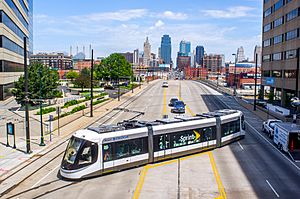
In July 2005, the Kansas City Area Transportation Authority (KCATA) launched Kansas City's first bus rapid transit line, the Metro Area Express (MAX). This line connects the River Market, Downtown, Union Station, Crown Center, and the Country Club Plaza. In 2013, construction began on the first two-mile (3.2 km) KC Streetcar line in downtown Kansas City. This project was funded by a $102 million vote in 2012. The streetcar runs between the River Market and Union Station and began operation in May 2016.
On November 7, 2017, Kansas City, Missouri, voters strongly approved a new single terminal at Kansas City International Airport, with 75% voting yes.
See also
- Timeline of Kansas City, Missouri history
Images for kids
-
Kansas City, Missouri, skyline from the Liberty Memorial


